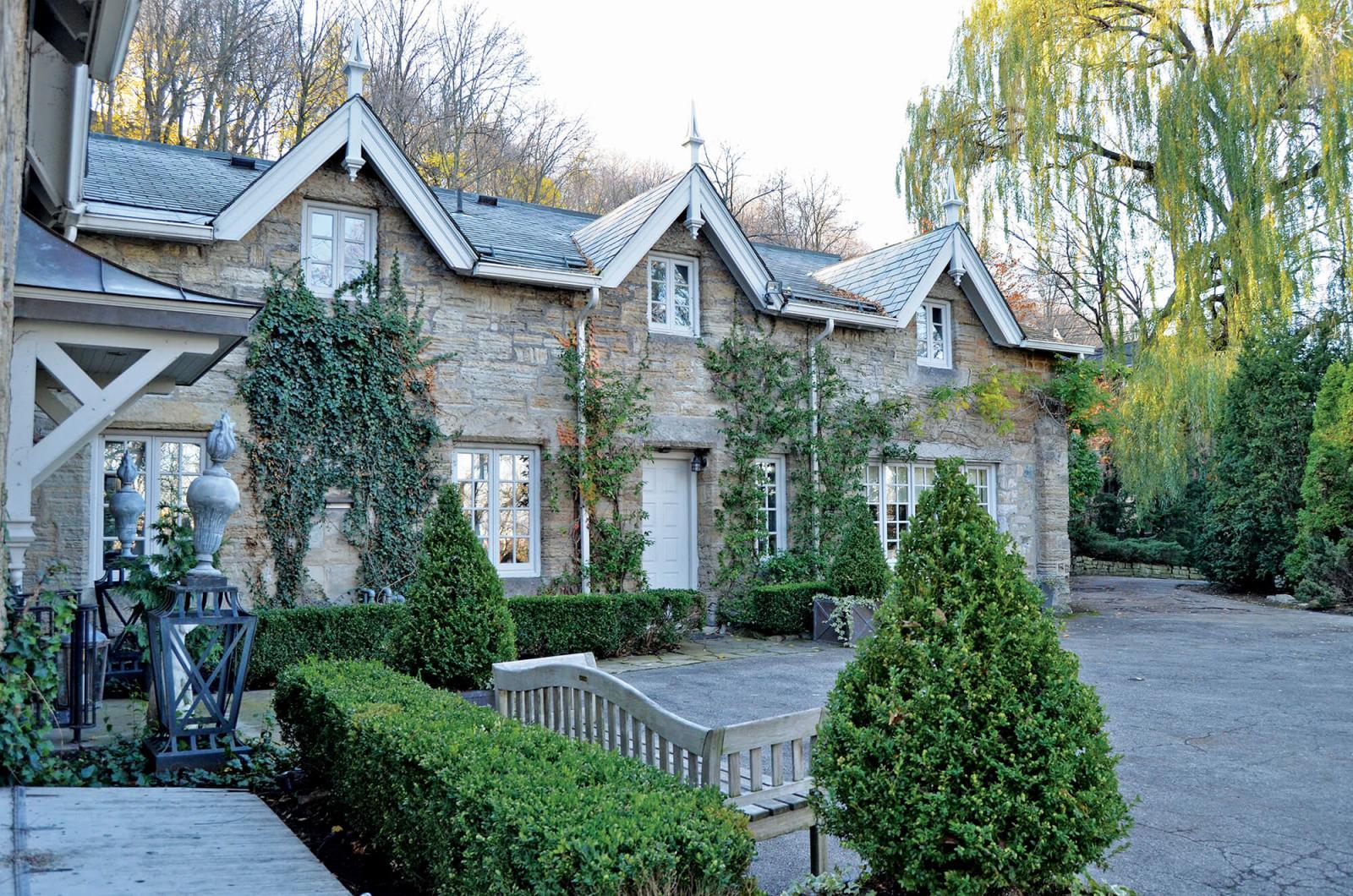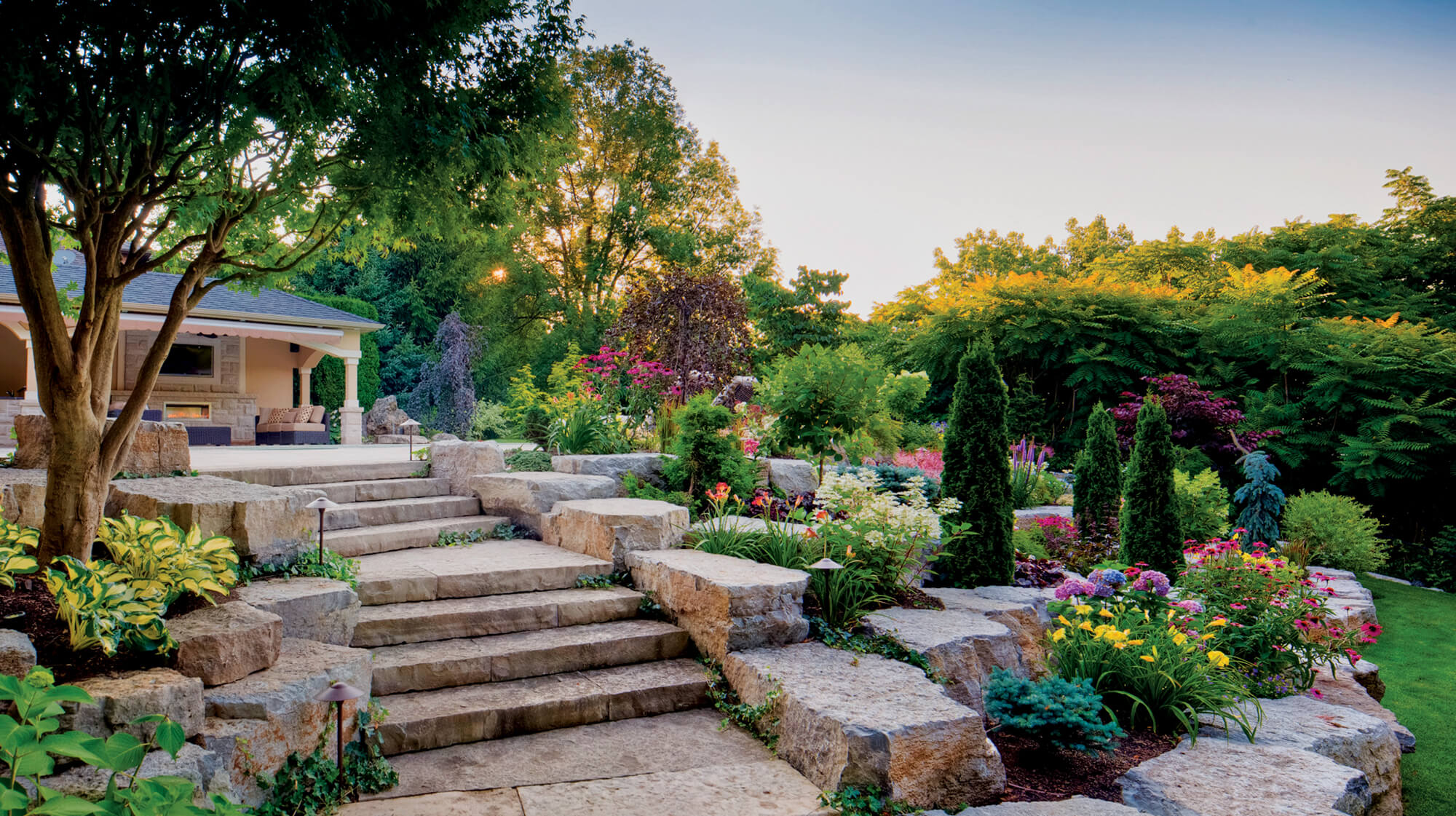April 1, 2016

Set along the edge of Hamilton’s escarpment, the entrance way of this Ravenscliffe Ave. home maintained by Shades of Summer Landscaping and Maintenance is softened with ample greenery and features dry stack retaining walls and flagstone accents.
Selling landscape: The investment angle
Make sure your customers understand how professional landscaping enhances property values
BY SCOTT BARBER
Whether it’s a beautiful backyard oasis or an inviting front garden and entranceway, there is no doubt amongst realtors that creatively designed and well maintained landscaping adds significantly to the value of a home.
Within the landscape industry too, it’s common sense that the services contractors provide both contribute to the immediate needs and desires of their clients as well as their long-term financial goals.
However, determining exactly how much property owners can expect to get back on their investments can be tricky to nail down, and that can make broaching the topic with clients difficult, when it should be a major selling tool.
Ottawa-based landscape designer Welwyn Wong makes a point of discussing the return on investment aspect of her projects with clients, and believes it goes a long way towards building trusting, long-lasting business relationships.
“As the daughter of a long-time real estate agent, it’s always something that I am thinking about. So when a client is starting to say that they want this, this and this, and they go on and on and on with a huge list, I’m automatically counting it all up in my head and falling back to how much the client thinks their house is worth, and what percentage of that value do they want to spend on the landscaping? That’s something that I take on as part of my responsibility of being a conscientious designer.”
Citing a Laval University study from 2001, Wong uses the rule of thumb that clients should avoid spending more than 25 per cent of the overall value of their home on landscaping.
“I tend to stay on the conservative side, only because we do see dips in the (housing) market, so if you do stay within the 15-25 per cent range, I think you’ll be able to reclaim that money regardless of what the market is doing.”
Like Wong, Brad Paton, president of Shades of Summer Landscaping and Maintenance in Hamilton, Ont., says that while clients don’t often come to his company with the notion of improving their property value at the top of their minds, he makes sure to incorporate basic real estate principles into his projects and design work.
“It’s kind of surprising to me that it’s not always on my client’s minds. Rather, clients seem to be looking towards projects that fit their personal wants or needs as well as their particular lifestyle. It’s often about what they want right now, and I don’t really know why they don’t usually look more into the future.”
The goal of every project should be to balance the two concerns, Paton says: provide what the client wants for their family in the short term, while ensuring the work will be a long-term benefit to property value.
Indeed, talking with clients about the long-term benefits of landscaping can be an effective marketing strategy, Paton adds. To illustrate the point, Paton talks about a home his company maintains in Burlington, Ont.
“I remember 25 years ago when we first started working on the property. It was a new build in a court with no trees and the hydro towers felt like they were right there in the backyard. The clients spent about $40,000 on the landscaping, and back then I thought that was a lot for them to spend on the property. But over the years since, that property has won Landscape Ontario awards and when you look out in the backyard now, you can’t even see the hydro towers because of the great big spruce trees planted all across the perimeter. There’s also beautiful stone landscaping and planting that has matured wonderfully and has been sheared and manicured consistently over the years. When I look at it today, I think if someone was to come in and recreate it today, it would cost at least $250,000. They invested $40,000 25 years ago, and now it has grown into something that would cost more than six times that amount. If someone was to do that to a kitchen, where they spent $40,000 25 years ago, they’d be ripping it out today. So it’s an interesting thing that when people think about property values and investments, some things really seem to hold their value where as others really do not.”
 Natural stone landscaping is both beautiful and durable and has remained in style for generations. This rear garden utilizes natural stone steps, armor stone retaining walls and a sophisticated planting arrangement that will appreciate in value as it reaches maturity.
Natural stone landscaping is both beautiful and durable and has remained in style for generations. This rear garden utilizes natural stone steps, armor stone retaining walls and a sophisticated planting arrangement that will appreciate in value as it reaches maturity.
When it comes to landscaping that is going to stand the test of time, Paton advises clients to consider spending a bit more to use high quality materials like natural stone products that are durable and tend to stay in style for generations.
There is a “timelessness” to expertly designed and crafted landscaping that simply can’t be matched by any other facet of home improvement, Paton argues.
Sabbir Chawala, a Markham, Ont.-based realtor with Century 21, agrees that landscaping, done right, can play a big role when selling a property. Especially when you consider how buyers go about searching for homes in 2016.
“Nowadays, the curb appeal of a home is more important than ever because the vast majority of buyers are looking at pictures of a property online before they decide if they want to go see the home. So having great curb appeal that really comes across on that first picture can really drive a lot of traffic to a property.”
Curb appeal alone can make a 10 per cent difference on the overall value of a home, Chawala says.
Lenard Lind, an Aurora, Ont.-based realtor with Remax concurred, adding that landscaping signals a strong message to buyers about pride of ownership.
“There is nothing more important than the front of the house,” when it comes time to sell, he said. “When I’m staging a house, I spend as much time outside on that first impression area to make sure sellers understand that buyers are going to think that is how you maintain the furnace, and that’s how you maintain everything about the house. So when they are waiting at the front door for the agent to open the lock box, they are noticing all sorts of things, from the paint on the doors and windows to whether or not the tumble stones are lifting. Those are all things the seller needs to take advantage of.”
While the landscaping at the front of a home is invaluable based on the first impression principle, the backyard is often just as important for buyers, Lind says.
“It can be your oasis and it could stop you from having to buy a cottage, so I often see people spending way more money in the backyard then they do at the front because it’s their paradise and they don’t have to share it with the neighbours, so to speak.”
Robert Bourne of Nutri-Lawn in Vancouver has thought a lot about the topic. “We are visual people,” he wrote on his company blog. “We judge a book by its cover, and when it comes to real estate, the cover is the exterior of your home. Everything from the colour of your front door, to the state of the roof, and the tidiness of the landscaping come together to build up, or tear down, expectations for what lies beyond the front door. Landscaping allows you to set the bar high for prospective homebuyers. Some realtors call this the halo effect, which is where one characteristic influences a person’s opinion on other details related to the matter at hand. For example, if your property is flanked by professionally trimmed hedges, colourful flower beds and a well-manicured lawn, home buyers are more likely to think that the same image of tranquility and cleanliness awaits inside.”
Ed Hansen, owner of Hansen Lawn and Gardens in Ottawa, Ont., also takes an active approach to educating clients about the investment component of landscaping by hosting seminars and regularly consulting with realtors in his area to keep up with the latest trends.
“While clients don’t necessarily come out and ask about it, they all expect us to be professionals. So at some point in the estimation process, you have to have a very frank conversation with the client about return on investment and how much money they plan on getting out of the landscape project they are looking at.”
When beginning a new project, Hansen makes sure his clients are thinking about how much their home is worth, and to use that as a guide when they are determining a budget. Like Wong, Hansen uses a rule of thumb number to prevent clients from going overboard.
Using a comprehensive study out of Virginia Tech University from the late 1990s, Hansen says well-designed and maintained landscaping can add upwards of 30 per cent to the value of a property. As such, he advises clients to keep their budget at or below that figure.
However, it should be noted the Virginia Tech research actually showed that some landscaping features and elements — design sophistication and plant size or maturity in particular — actually added up to 42 per cent more to the price of the homes studied, making Hansen’s 30 per cent figure, and Wong’s 25 per cent, quite prudent.
The only caveat, real estate agent Lenard Lind says, is that regardless of how much a homeowner spends on an initial landscaping project, he or she needs to be prepared to either do the gardening and pruning themselves, or hire a professional maintenance company, and that must be factored into budgets from the start.
The bottom line, according to the academic research as well as opinions from the landscapers and realtors interviewed, is that homeowners should balance the short and long-term benefits of any landscaping they are looking at doing, to ensure they get the most enjoyment out of their property while also maximizing the long run return they will get on their investment.